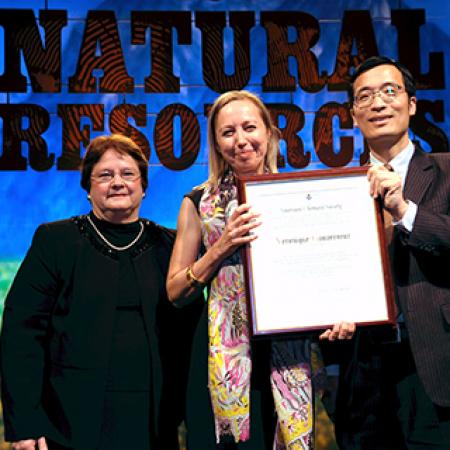Véronique Gouverneur's work on fluorine recognised by American Chemical Society
Merton Tutorial Fellow in Organic Chemistry Professor Véronique Gouverneur was the recipient of this year's American Chemical Society (ACS) Award for Creative Work in Fluorine Chemistry, for her outstanding contributions to the advancement of the chemistry of fluorine. The citation referred to "her contribution to late-stage fluorination and for invigorating creatively the field of [18F] radiochemistry for applications in Positron Emission Tomography (PET)."
The award was presented to Professor Gouverneur at the 249th ACS National Meeting in March, in Denver, Colorado, USA. A symposium in honour of Professor Gouverneur was held at the National Meeting, at which a number of papers on fluorine chemistry were presented, and which ended with Professor Gouverneur giving her award address, entitled 'Expanding the range of 18F-tags for PET applications.'
The award, which is sponsored by the Juhua Group Technology Center (China), consists of $5,000 and a certificate, and is presented annually.
Professor Gouverneur heads a laboratory (VGL) dedicated to discovering new agents of medicinal value through major advances in fluorine chemistry. To reach this goal, VGL builds on experience in synthesis and catalysis and applies the tools of physical organic chemistry to design superior fluorination reagents of predicated reactivity.
Her research is divided into two interlinked categories:
- chemical advances for the synthesis of structurally and biologically compelling fluorinated molecules for applications in medicinal chemistry;
- [18F]-radiochemical advances for the production of [18F]-labelled biomarkers for applications in molecular imaging (PET). Such advances are crucial to interrogate molecular interactions in organisms using radioemission imaging methods and to develop new synthetic [18F]-labelled (bio)molecules tools to diagnose, monitor and treat diseases.
Her pioneering role in opening up and defining the area of 'precision [18F]-radiochemistry' has created a step change in thinking by allowing functional as opposed to passive [18F]-labelling. By merging catalytic fluorination with radiochemistry, she is developing creative processes to streamline access to a plethora of [18F]-radiotracers that are either difficult to prepare or not within reach using conventional methods. These discoveries make a direct impact in the clinic, and open vast opportunities in the field of molecular imaging.
